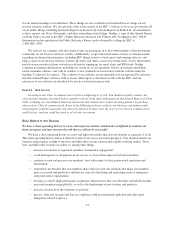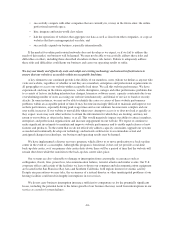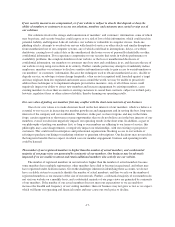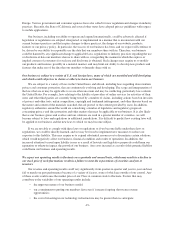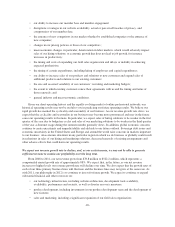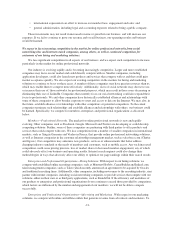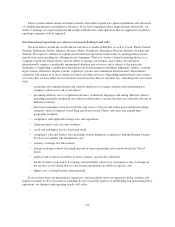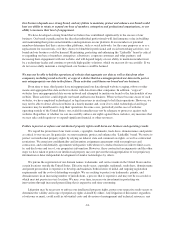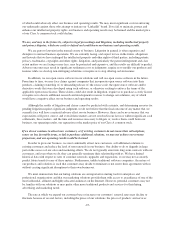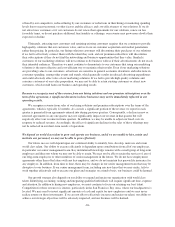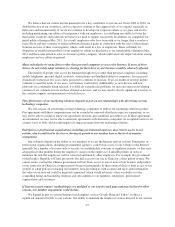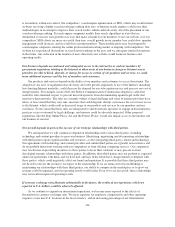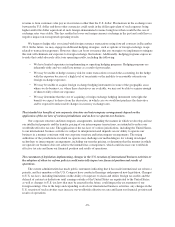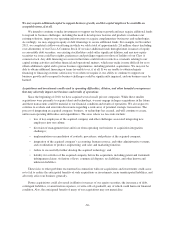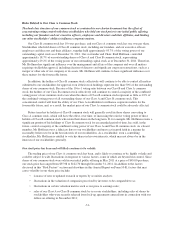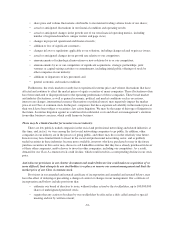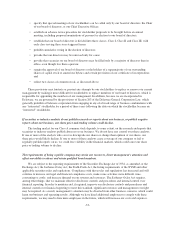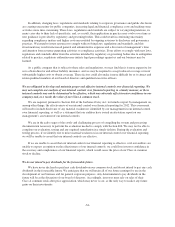LinkedIn 2011 Annual Report Download - page 29
Download and view the complete annual report
Please find page 29 of the 2011 LinkedIn annual report below. You can navigate through the pages in the report by either clicking on the pages listed below, or by using the keyword search tool below to find specific information within the annual report.of which could adversely affect our business and operating results. We may incur significant costs in enforcing
our trademarks against those who attempt to imitate our “LinkedIn” brand. If we fail to maintain, protect and
enhance our intellectual property rights, our business and operating results may be harmed and the market price
of our Class A common stock could decline.
We are, and may in the future be, subject to legal proceedings and litigation, including intellectual property
and privacy disputes, which are costly to defend and could harm our business and operating results.
We are party to lawsuits in the normal course of business. Litigation in general is often expensive and
disruptive to normal business operations. We are currently facing, and expect to face in the future, allegations
and lawsuits that we have infringed the intellectual property and other rights of third parties, including patents,
privacy, trademarks, copyrights and other rights. Litigation, and particularly the patent infringement and class
action matters we are facing or may face, may be protracted and expensive, and the results are difficult to predict.
Adverse outcomes may result in significant settlement costs or judgments, require us to modify our products and
features while we develop non-infringing substitutes or require us to stop offering certain features.
In addition, we use open source software in our solutions and will use open source software in the future.
From time to time, we may face claims against companies that incorporate open source software into their
products, claiming ownership of, or demanding release of, the source code, the open source software and/or
derivative works that were developed using such software, or otherwise seeking to enforce the terms of the
applicable open source license. These claims could also result in litigation, require us to purchase a costly license
or require us to devote additional research and development resources to change our solutions, any of which
would have a negative effect on our business and operating results.
Although the results of litigation and claims cannot be predicted with certainty, and determining reserves for
pending litigation requires significant judgment, we do not believe that the final outcome of any matter that we
currently face will have a material adverse effect on our business. However, there can be no assurance that our
expectations will prove correct, and even if these matters are not resolved in our favor or without significant cash
settlements, these matters, and the time and resources necessary to litigate or, resolve them, could harm our
business, our operating results, our reputation or the market price of our Class A common stock.
If we do not continue to attract new customers, or if existing customers do not renew their subscriptions,
renew on less favorable terms, or fail to purchase additional solutions, we may not achieve our revenue
projections, and our operating results would be harmed.
In order to grow our business, we must continually attract new customers, sell additional solutions to
existing customers and reduce the level of non-renewals in our business. Our ability to do so depends in large
part on the success of our sales and marketing efforts. We do not typically enter into long-term contracts with our
customers, and even when we do, they can generally terminate their relationship with us. We have limited
historical data with respect to rates of customer renewals, upgrades and expansions, so we may not accurately
predict future trends for any of these metrics. Furthermore, unlike traditional software companies, the nature of
our products and solutions is such that customers may decide to terminate or not renew their agreements with us
without causing significant disruptions to their own businesses.
We must demonstrate that our hiring solutions are an important recruiting tool for enterprises and
professional organizations and that our marketing solutions provide them with access to an audience of one of the
most influential, affluent and highly educated audiences on the Internet. However, potential customers may not
be familiar with our solutions or may prefer other more traditional products and services for their hiring,
advertising and marketing needs.
The rate at which we expand our customer base or increase our customers’ renewal rates may decline or
fluctuate because of several factors, including the prices of our solutions, the prices of products and services
-25-


